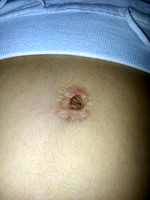Floating belly button tummy tuck
There are several ways to do a tummy tuck, and the best method is determined by what needs to be corrected. The floating umbilicus technique is used when you have loose skin or muscle wall above the belly button. The stalk is a fibrous track that used to be the umbilical blood vessels and no longer serves a purpose other then anchoring the umbilicus.
The stalk is released from the muscle allowing the muscle to be repaired all the way up to the ribs, and normally it is reattached a little lower on the abdominal wall to tighten the skin above the belly button. This only works when there is a little loose skin.
When more skin needs to be removed, the umbilicus is left on the muscle and the skin is pulled down past it. The excess is removed and a new button hole is made for the belly button to come back out.
If there is no loose skin or muscle above the belly button, a mini tummy tuck is preferred. It is hard to provide you with alternatives without knowing if they apply to you. (Joseph Mele, MD, Walnut Creek Plastic Surgeon)
Difference between results of a traditional tummy tuck and a floating tummy tuck
A traditional tummy tuck keeps the umbilicus intact while the floating tummy tuck disconnects the umbilical stalk allowing it to move inferiorly if necessary. There are many problems with the floating tummy tuck. One the umbilicus may be moved to a lower, usually abnormal position. Second, the umbilicus usually has a flatter, unnatural appearance. A traditional umbilicus remains connected to the deep tissue which will allow the umbilicus to have more of an ‘innie’ rather than ‘outie’ contour. The goal is to maintain the anatomic location and appearance as best as possible. (Elizabeth S. Harris, MD, San Antonio Plastic Surgeon)
Traditional Tummy tuck vs Floating belly button tummy tuck
There are some patients in which this procedure can be a good option, and in my opinion is: when a patient has a small skin excess, and you need to thigh the abdominal muscles. Usually this patients are thin ones, with a high belly button (Francisco Sauceda, MD, Mexico Plastic Surgeon)
Floating belly button in a tummy tuck
The idea of floating the belly button, keeping the belly button attached to the skin flap is actually an old idea where only a more modest amount of skin laxity is present, and the belly button is set lower as the skin moves down. Most now feel the idea was a bad one as the belly button belongs in only one place.
The surgery suggested to you is not a ‘float’ procedure as the belly button is attached to the starting point, it is just a means for access to the length of the abdominal muscles for repair and plication. This is a good idea. Your belly button will heal back firmly and look just fine. (Peter E. Johnson, MD, Chicago Plastic Surgeon)
Traditional versus floating belly button
Floating the belly button is not a new technique. It is called “floating” because the stalk is cut and the belly button is “floated” along with the skin to a new lower position. In a traditional tummy tuck the stalk is not cut. The skin is cut around the belly button, left attached to the stalk, and brought through the skin which has been pulled down. In this way, the belly button sits at the same level it used to sit, and all of the connections underneath are maintained.
Reasons to float the belly button are 1) if you do not have a lot of excess skin or 2) if it is already “floated” due to an underlying hernia. In order to do the traditional method of leaving it attached, you need to have enough loose skin so that the hole you create from around the belly button is on the skin that is removed (otherwise you end up with a T at the bottom incision, or a small vertical incision between the belly button and horizontal tummy tuck scar.)
An endoscopic approach is useful only when you want to tighten the muscles but are not using a full incision. The best thing to do is consult with a board certified plastic surgeon. He or she can explain to you what you are a candidate for based on your anatomy, and can explain the differences and advantages to figure out what is best for you. (Anita Patel, MD, Beverly Hills Plastic Surgeon)
Traditional tummy tuck vs floating belly button
The traditional tummy tuck is the most commonly used procedure. This is best for removal of the excess skin and tightening the abdominal wall (which is the main reason to have a tummy tuck). The technique that floats the belly button is used only in select cases with minimal excess skin. If used in more severe cases it may distort the belly button and lower it too much. (Donald Nunn, MD, Atlanta Plastic Surgeon
There are several very effective techniques for a tummy tuck and the appropriate one depends upon your anatomy and particular needs. A mini tummy tuck treats only excess below the belly button, a full tummy tuck treats the entire abdomen (but not the flanks and lower back – an extended tummy tuck is better here), and floating the belly button leaves it attached to the skin and is generally used for someone “in between.” This is a good technique in the right candidate, but it tends to lower the position of the belly button which can look odd if placed too low. Discuss this in detail with your surgeon. (Vincent P. Marin, MD, San Diego Plastic Surgeon)
The floating belly button tummy tuck is for patients that stretch the lower abdomen more and the belly button is positioned too high. The indication for each procedure is different. (Kamran Khoobehi, MD, New Orleans Plastic Surgeon)
Floating belly button with tummy tuck
Are you having a mini tummy tuck? One of the issues with a mini tuck is the inability to repair the muscle the full way up which can lead to a “pooch” above the belly button while the lower half of the tummy is flat and tight. Floating the belly button allows the surgeon to get all the way up there to avoid this. Another reason that we sometimes float the belly button is to avoid the scar around it when doing a full tummy tuck.
I have used this technique in both cases. It is possible to get around it to repair the muscle but it can be more tricky/tedious. Floating it allows you to tack it back down and maybe even slightly modify where it goes although not very far.
The technique should be done carefully whereby any fascial defect or hole is repaired to avoid a hernia. Otherwise I have found it to be a useful procedure. (Tiffany McCormack, MD, Reno Plastic Surgeon)











